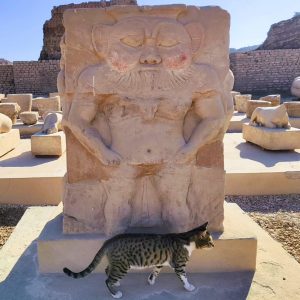
The Cheerful Guardian: How the Ancient Egyptian God Bes Still Lives in Today’s ‘Besbes’ for Cats
In the captivating world of ancient Egyptian mythology, Bes stands out as a truly unique figure. Unlike the grand and regal gods who ruled over sun, sky, or the underworld, Bes took on a more personal mission—protecting homes, women, children, and bringing joy to daily life. He didn’t sit on a golden throne or preside over vast temples; instead, he danced, played music, and made faces to scare away evil. He was, in every sense, the god of good vibes.
A God With a Goblin’s Charm
Most Egyptian gods were depicted in side profile, graceful and idealized. But Bes? He looked you straight in the eye. With a lion-like face, sticking out his tongue, feathered crown, bow legs, bulging eyes, and a wild beard, Bes looked more like a party-crashing dwarf than a divine protector—and that’s exactly what made him so beloved.
This odd-looking gentleman has roots deeper and wider than many realize. A relief of Bes was excavated not in Egypt, but in Aslantaş, an ancient Neo-Hittite city in southern Turkey. Created in the late 8th century BCE, the image of Bes guarded a city gate—a perfect job for a god known to fend off hostile spirits and wild beasts. It’s striking to find him here, considering that he was never part of Egypt’s official state religion and had no temples of his own. But this only reinforces how deeply woven he was into the hearts and homes of everyday people.
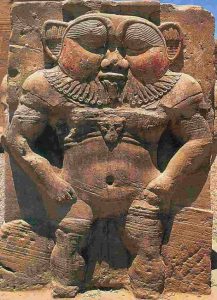
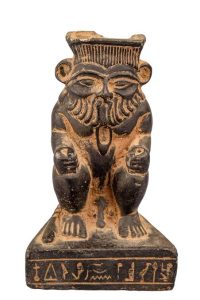
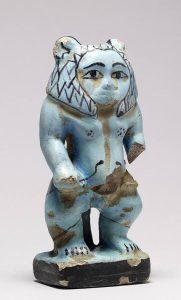
Magic stela of Bes-Horus
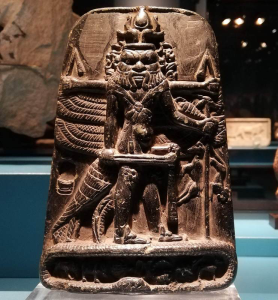
From Egypt to the World
Though often labeled an Egyptian god, Bes’s reach went far beyond the Nile Valley. Originally called Aha, his worship was already popular in the Levant by the Late Bronze Age. His cult later spread to Punic Sicily, Ibiza, Iran, and Armenia, and eventually across the entire Mediterranean during the Roman Empire. That makes Bes not just a household protector, but one of ancient history’s most traveled deities.
His role was “apotropaic,” meaning he was a guardian against evil. Bes protected women during childbirth, kept demons at bay, and made himself intentionally grotesque to scare off dark forces. His dance, comical to us now, was part of this protective magic. He also fought wild animals and carried weapons like daggers, and on some reliefs—like the one in Aslantaş—he’s shown with two monkeys perched on his shoulders.
Everyday God of Magic and Music
Bes wasn’t alone in the domestic sphere. He shared this sacred territory with figures like the hippopotamus goddess Tawaret and the lesser-known but powerful Tutu. While the state gods (like Amun or Ra) kept the cosmos in check, domestic gods like Bes ensured safety, joy, and comfort at home.
Because of this, Bes’s image appeared everywhere—on amulets, furniture, cosmetics jars, columns, and even headrests. Magic rituals and healing stelas from the Ptolemaic period show Bes mixed with other divine figures like Horus and Tutu, creating hybrid protectors with supercharged power.
And yes, he could be gender-fluid too. His female counterpart, Beset, was often portrayed as a naked dancing woman—essentially a reflection of Bes himself.
The Story of Hathor and the God Who Could Party
One of Bes’s most delightful appearances is in a myth involving Hathor, the goddess of love and joy. After fleeing to Nubia in a fit of anger, Hathor refuses to return to her father Ra. The gods send Bes to lure her back. So what does he do? He throws a party. With music, dancing, and a little too much wine, he convinces Hathor to return to Egypt. From that moment, he becomes her joyful companion, often depicted playing tambourines, harps, or flutes.
Bes’s music wasn’t just for fun—it was powerful magic. His tunes could banish demons and heal the sick, making him a symbol of both protection and happiness.
Bes in Modern Egypt: A Feline Echo
Now, here’s where ancient myth meets modern life. In Egypt today, when people want to call a cat, they often say “besbes”—a sound that, while cute and catchy, may be more meaningful than it seems.
Cats were sacred in ancient Egypt, revered for their grace, hunting skills, and protective nature. The goddess Bastet, another household protector, was depicted as a lioness or a woman with a cat’s head. She, like Bes, was connected to joy, fertility, and home life. Over time, the friendly call of “besbes” may have evolved from Bes’s name itself—a whisper from the past that still lingers in Egyptian streets and homes.
It makes sense: “besbes” is light, musical, and high-pitched—perfect for grabbing a cat’s attention. It’s also a perfect reflection of the qualities Bes embodied: warmth, protection, playfulness, and an unshakable sense of home.
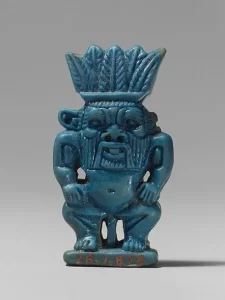

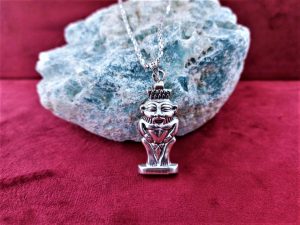
Final Thoughts: The God Who Danced Through History
In a pantheon full of mighty, mysterious figures, Bes remains one of the most charming and approachable. He was a god for the people, not the palaces. Whether etched onto a city gate in Anatolia, depicted in magic rituals in Hellenistic Egypt, or quietly echoed in the playful call to a neighborhood cat, Bes continues to guard, dance, and protect in his own joyful way.
So next time you see someone calling “besbes” to a street cat, smile. You’re witnessing an echo of a 4,000-year-old tradition—a living, purring link to a dwarf god who never stopped caring for us.
Enjoyed this story? Share it with a fellow mythology lover or follow us for more deep dives into Egypt’s ancient deities and their echoes in modern culture. Got a topic suggestion? Drop it in the comments!
www.egyptfemaletourguide.com
Discover more from Egypt Female Tour Guide
Subscribe to get the latest posts sent to your email.







